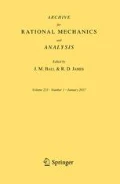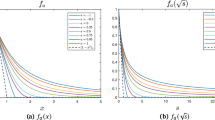Abstract
It is conjectured that the generalization of the Constantin–Lax–Majda model (gCLM) \(\omega _t + a u\omega _x = u_x \omega \), due to Okamoto, Sakajo and Wunsch, can develop a finite time singularity from smooth initial data for \(a < 1\). For the endpoint case where a is close to and less than 1, we prove finite time asymptotically self-similar blowup of gCLM on a circle from a class of smooth initial data. For the gCLM on a circle with the same initial data, if the strength of advection a is slightly larger than 1, we prove that the solution exists globally with \(|| \omega (t)||_{H^1}\) decaying in a rate of \(O(t^{-1})\) for large time. The transition threshold between two different behaviors is \(a=1\), which corresponds to the De Gregorio model.
Similar content being viewed by others
References
Castro, A., Córdoba, D.: Infinite energy solutions of the surface quasi-geostrophic equation. Adv. Math. 225(4), 1820–1829, 2010
Chen, J.: Singularity formation and global well-posedness for the generalized Constantin–Lax–Majda equation with dissipation. Nonlinearity 33(5), 2502, 2020
Chen, J., Hou, T.Y.: Finite time blowup of 2D Boussinesq and 3D Euler equations with \({C}^{1,\alpha }\) velocity and boundary. Commun. Math. Phys. 383(3), 1559–1667, 2021
Chen, J., Hou, T.Y., Huang, D.: On the finite time blowup of the De Gregorio model for the 3D Euler equations. Commun. Pure Appl. Math. 74(6), 1282–1350, 2021
Choi, K., Hou, T.Y., Kiselev, A., Luo, G., Sverak, V., Yao, Y.: On the finite-time blowup of a 1D model for the 3D axisymmetric Euler equations. CPAM 70(11), 2218–2243, 2017
Constantin, P., Lax, P.D., Majda, A.: A simple one-dimensional model for the three-dimensional vorticity equation. CPAM 38(6), 715–724, 1985
Córdoba, A., Córdoba, D., Fontelos, M.A.: Formation of singularities for a transport equation with nonlocal velocity. Ann. Math. 162, 1377–1389, 2005
De Gregorio, S.: On a one-dimensional model for the three-dimensional vorticity equation. J. Stat. Phys. 59(5–6), 1251–1263, 1990
De Gregorio, S.: A partial differential equation arising in a 1D model for the 3D vorticity equation. Math. Methods Appl. Sci. 19(15), 1233–1255, 1996
Elgindi, T.M.: Finite-time singularity formation for \({C}^{1,\alpha }\) solutions to the incompressible Euler equations on \(R^3\). arXiv:1904.04795, 2019.
Elgindi, T.M., Ghoul, T.-E., Masmoudi, N.: Stable self-similar blowup for a family of nonlocal transport equations. arXiv:1906.05811, 2019.
Elgindi, T.M., Jeong, I.-J.: On the effects of advection and vortex stretching. Arch. Ration. Mech. Anal. 235, 1763–1817, 2019
Hou, T.Y., Lei, Z.: On the stabilizing effect of convection in three-dimensional incompressible flows. Commun. Pure Appl. Math. 62(4), 501–564, 2009
Hou, T.Y., Li, C.: Dynamic stability of the three-dimensional axisymmetric Navier–Stokes equations with swirl. Commun. Pure Appl. Math. 61(5), 661–697, 2008
Jia, H., Stewart, S., Sverak, V.: On the de gregorio modification of the Constantin–Lax–Majda model. Arch. Ration. Mech. Anal. 231(2), 1269–1304, 2019
Kato, T., Ponce, G.: Commutator estimates and the Euler and Navier–Stokes equations. Commun. Pure Appl. Math. 41(7), 891–907, 1988
Kenig, C.E., Merle, F.: Global well-posedness, scattering and blow-up for the energy-critical, focusing, non-linear Schrödinger equation in the radial case. Invent. Math. 166(3), 645–675, 2006
Landman, M.J., Papanicolaou, G.C., Sulem, C., Sulem, P.L.: Rate of blowup for solutions of the nonlinear Schrödinger equation at critical dimension. Phys. Rev. A 38(8), 3837, 1988
Lei, Z., Liu, J., Ren, X.: On the Constantin–Lax–Majda model with convection. Commun. Math. Phys. 375, 1–19, 2019
Lushnikov, P.M., Silantyev, D.A., Siegel, M.: Collapse vs. blow up and global existence in the generalized Constantin–Lax–Majda equation. arXiv preprint arXiv:2010.01201, 2020.
Martel, Y., Merle, F., Raphaël, P.: Blow up for the critical generalized Korteweg–de Vries equation. I: Dynamics near the soliton. Acta Math. 212(1), 59–140, 2014
McLaughlin, D.W., Papanicolaou, G.C., Sulem, C., Sulem, P.L.: Focusing singularity of the cubic Schrödinger equation. Phys. Rev. A 34(2), 1200, 1986
Merle, F., Raphael, P.: The blow-up dynamic and upper bound on the blow-up rate for critical nonlinear Schrödinger equation. Ann. Math. 161, 157–222, 2005
Merle, F., Zaag, H.: Stability of the blow-up profile for equations of the type \(u_t= \delta u + | u|^{ p- 1} u \). Duke Math. J. 86(1), 143–195, 1997
Merle, F., Zaag, H.: On the stability of the notion of non-characteristic point and blow-up profile for semilinear wave equations. Commun. Math. Phys. 333(3), 1529–1562, 2015
Okamoto, H., Sakajo, T., Wunsch, M.: On a generalization of the Constantin–Lax–Majda equation. Nonlinearity 21(10), 2447–2461, 2008
Okamoto, H., Sakajo, T., Wunsch, M.: Steady-states and traveling-wave solutions of the generalized Constantin–Lax–Majda equation. Discrete Contin. Dyn. Syst. A 34(8), 3155, 2014
Acknowledgements
The author would like to thank Thomas Hou for helpful comments on an earlier version of this work. We would also like to thank the referee for the constructive comments on the original manuscript, which improve the quality of our paper. This research was supported in part by Grants DMS-1907977 and DMS-1912654 from the National Science Foundation.
Author information
Authors and Affiliations
Corresponding author
Additional information
Communicated by P. Constantin.
Publisher's Note
Springer Nature remains neutral with regard to jurisdictional claims in published maps and institutional affiliations.
Appendix A
Appendix A
Lemma A.1
Suppose that \(f \in L^2( (\sin \frac{x}{2})^{-2} )\). We have
Proof
Firstly, we consider \(f \in C^{\infty }\). Using the Tricomi identity of the Hilbert transform (see for example [4, 12]), we obtain
Since \(f \in L^2( ( \sin \frac{x}{2})^{-2} )\), we have \(f(0) = 0\) and obtain (A.1) for \(f \in C^{\infty }\). For general f, we can find a sequence \(f_n \in C^{\infty }\) such that \(f_n \rightarrow f\) in \(L^2( ( \sin \frac{x}{2})^{-2} )\). Clearly, we have \(H f_n \rightarrow Hf \) and \(f_n \cot \frac{x}{2} \rightarrow f \cot \frac{x}{2}\) in \(L^2\). Using the Cauchy–Schwarz inequality, we get \( Hf_n(0) \rightarrow Hf(0)\). Applying (A.1) to \(f_n\) and then taking \(n\rightarrow \infty \) concludes the proof. \(\square \)
Next, we prove Lemmas 2.6 and 2.7 .
Proof of Lemma 2.6
Applying integration by parts yields
It follows
Note that \((\sin x - \sin y) \cot \frac{x-y}{2} = 2 \sin \frac{x-y}{2} \cos \frac{x+y}{2} \cot \frac{x-y}{2} = 2 \cos \frac{x+y}{2} \cos \frac{x-y}{2} = \cos x + \cos y.\) We conclude
\(\square \)
Proof of Lemma 2.7
Using the Cauchy–Schwarz inequality, we obtain
for any \( x \in S^1\), which concludes the proof. \(\square \)
Rights and permissions
About this article
Cite this article
Chen, J. On the Slightly Perturbed De Gregorio Model on \(S^1\). Arch Rational Mech Anal 241, 1843–1869 (2021). https://doi.org/10.1007/s00205-021-01685-w
Received:
Accepted:
Published:
Issue Date:
DOI: https://doi.org/10.1007/s00205-021-01685-w




